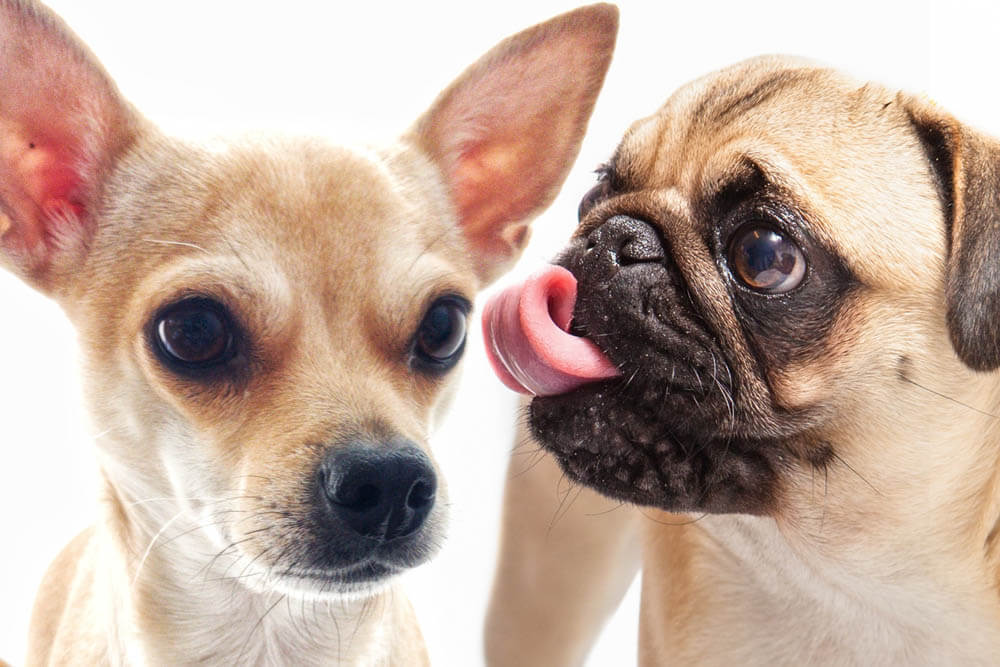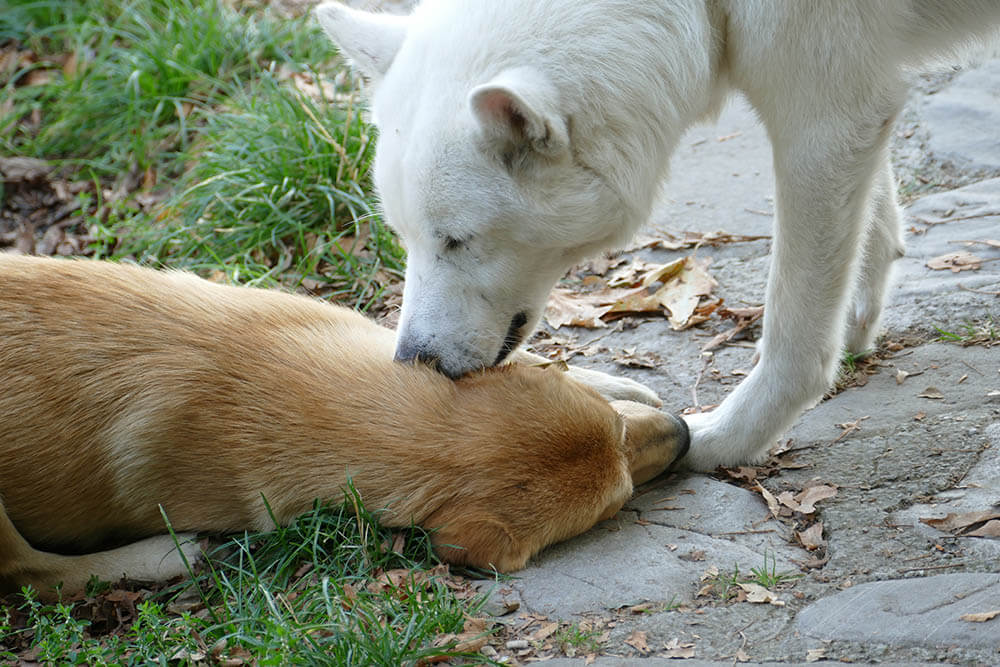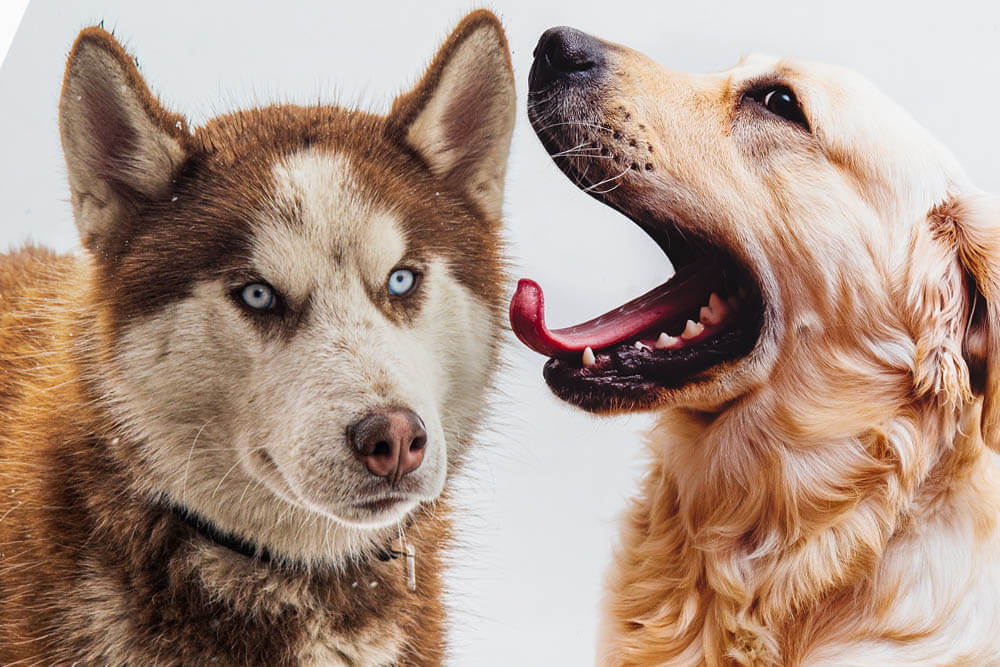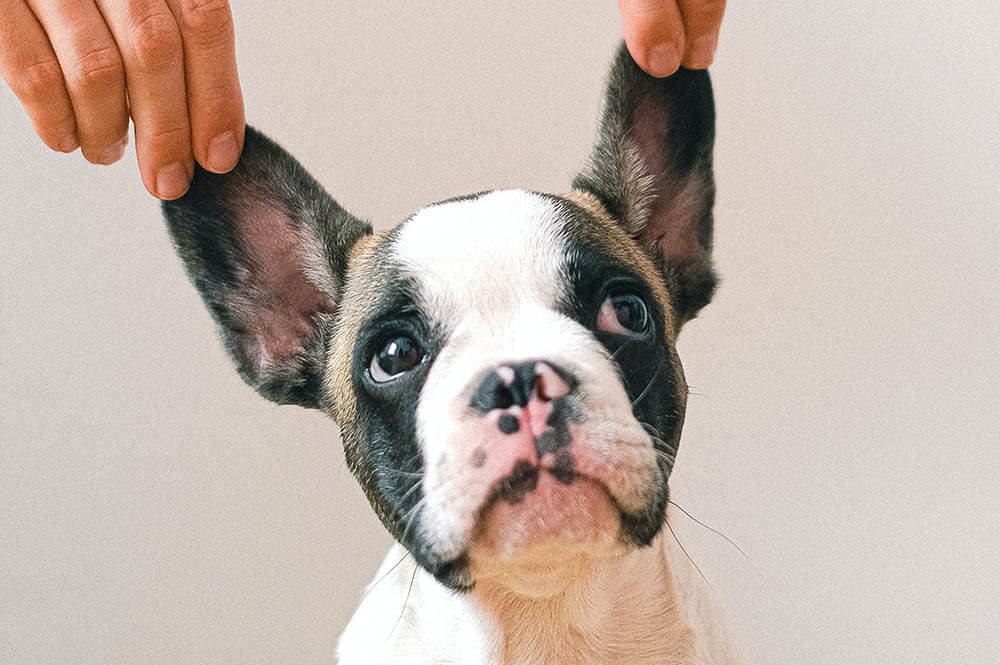Yeah, why do dogs lick each other’s ears? Is it because they like the taste of ear wax? Or is the canine ear particularly adept at catching airborne food particles?
Believe it or not, there are good reasons to lick ears. We’re not saying you should start licking your friends’ ears, but if you catch your dogs engaging in the behavior, know that they’ve not lost their minds.
So why do dogs lick each other’s ears? Read on to find out!

10 Reasons Why Dogs Lick Each Other’s Ears
Modern canines descended from wolf-like ancestors whose survival depended on belonging to a pack. And for a pack to be successful, each member needed to know how to communicate properly with others.
In addition to barking and howling, licking was an effective way for these ancient doggos to make their thoughts and emotions known. They then passed these behaviors down to modern dogs, including the domestic pooch. When you see your pet licking another’s ears, they’re therefore expressing an instinct that has helped their kind communicate with one another for millennia.
Below, we’ve compiled the 10 meanings behind this fascinating instinctive behavior.
1. Grooming
It seems odd to think of dogs as hygienic animals, but our furry friends do value cleanliness in their own doggy way. And what’s their most reliable cleaning tool? That’s right: their tongue.
Unfortunately, the canine tongue isn’t long enough to allow your pooch to lick their own ears clean. They must therefore rely on another dog—usually one belonging to their pack—to lick their ears for them.
Licking one another is an essential aspect of mutual grooming in canine families. In fact, dogs don’t just lick each other’s ears but other body parts, too—including the privates. As weird as this may seem to us humans, this is natural and comfortable for dogs.
Ear-licking rids ears of everything from dirt to mites. However, constant and/or aggressive licking can irritate a dog’s ears and may even cause infections. Whenever you notice a dog overdoing the grooming process, stop them so that they learn to avoid repeating the behavior. Check the other’s ears; if you notice red, irritated skin, consult a vet regarding treatment.
2. Submission
Like their wild cousins and ancestors, domestic dogs are pack animals. Packs have hierarchies, with the older and stronger individuals typically at the top, and the younger, smaller ones at the bottom.
Lower-ranking dogs show deference toward the higher-ranking ones through submissive behaviors such as licking. This is why you’ll see a puppy licking a parent’s mouth, or why your pet tries to lick your face.
If you see one pooch licking another’s ears, the first may therefore be displaying their respect and reverence for the second.
3. Affection
Another purpose of licking is to show affection. So when a dog licks another pet or their favorite humans, they’re essentially giving them a kiss and saying, “I love you.”
In fact, licking is among the most crucial canine behaviors, as it strengthens the bond among pack members.
4. Saying “Hi!”
Dogs sniff each other’s butts for several reasons. One of them is to get to know each other. After all, the butt is a source of fascinating scents that offer abundant information about a dog, including what they’ve been eating, their gender, their health, and more.
Another reason for a dog to sniff another’s butt is to say “Hello!” to that other dog. But what happens when the second dog doesn’t want a cold, wet nose going anywhere near their posterior? The first dog is forced to do the next best thing, and that’s to lick the second’s mouth, snout, or ears.
5. Self-soothing
The simple act of licking things, people, and pack members stimulates the dog’s nervous system to release chemicals known as endorphins. Endorphins trigger feelings of pleasure and positive well-being as well as reduce discomfort and pain.
In short, some dogs lick each other’s ears because the behavior gives them pleasure and comfort.
Therefore, if you see one dog constantly licking another’s ears, it may be a sign the first is under a lot of anxiety, and/or stress. Take such a dog to a vet or veterinary behaviorist, as they can treat underlying health issues that lead to mental health problems. They can even prescribe anti-anxiety medication.
Excessive licking could also mean a dog is trying to relieve feelings of unhappiness due to extreme boredom. This is why you should give your dog lots of mental and physical exercise, including training and daily walks. Make sure your dog has lots of toys to play with, too.

6. Sensing infection
The powerful canine sense of smell allows your pooch to identify an infection long before its symptoms have manifested in ways observable to humans.
But why would a dog lick another’s infected ear? It all goes back to the fact that dogs are pack animals. Because pack members rely on one another to survive, they’re driven to care for their family members. Therefore, when a dog senses that their packmate has an infected ear, they’ll “treat” the infection by licking it clean.
Of course, dogs also have a more selfish, exceptionally disgusting reason to lick infected ears. Sometimes, infections produce yeast, discharge, or pus, whose taste a dog may enjoy. It’s for this reason you should have a vet examine a dog’s ears if another keeps licking it; they may have an infection that needs treatment.
7. Providing comfort
If one dog senses another is suffering due to a health issue such as heat stroke, the first dog may lick the second’s ears to give them comfort or even prevent them from losing consciousness.
This is why it’s always a good idea to check on your dogs whenever you see one licking the other’s ears. Examine the dog receiving the licking for signs of trouble, such as excessive panting or drooling, increased heart rate, high body temperature, overly pale or reddish gums, weakness, and the like. Call a vet immediately if you observe such symptoms.
8. Seeking attention
Dogs seek attention for several reasons. Maybe they want to play. Maybe they need help. Or maybe they’re just feeling a tad bit neglected, and the attention itself brings them joy.
To gain another’s attention, a dog may resort to various behaviors, such as barking, playful nipping, and, of course, licking. A pooch may choose the ear-licking option if they want to gently rouse a dog from sleep.
9. Yummy ear wax
There’s no getting around it; some dogs simply find ear wax mouthwatering. According to experts, ear wax is salty, so maybe it’s like salted caramel for dogs. If you think that’s weird, remember that dogs love the smell of garbage and eat their own poop.
Does your pooch enjoy eating ear wax? Then they may end up bothering another dog in their search for their unsavory snack. Make sure to step in before that other dog gets annoyed with the ear wax lover or their ears become irritated due to all that licking.
10. Obsessive-compulsive disorder
Like humans, dogs can develop obsessive-compulsive disorder.
According to the American Kennel Club, canine compulsive disorder, or CCD, is “identified by normal dog behaviors that are performed in such an extreme, repetitive way that they are difficult for the dog to stop and can interfere with the dog’s ability to function.”
If you observe your dog licking things—including another dog’s ears—for extended periods every day, then they may be exhibiting one of the main symptoms of CCD.
In addition to compulsive licking, other things to watch out for include extreme repetitions of pacing, tail-chasing, spinning, patterned barking, freezing and staring, drinking, and dirt-eating.
CCD is linked to anxiety and stress. The neurological disorder also has a genetic component; certain breeds (including German Shepherds, Retrievers, and Border Collies) are more prone to suffer from it.
A veterinary behaviorist can help treat CCD.

Is Ear-Licking Harmful?
Ear-licking is natural canine behavior that, in most cases, can benefit the psychological and physical health of the dog getting their ears licked.
However, too much licking can cause a buildup of moisture in the ears, which in turn can create conditions conducive to infection. It can also irritate the inner ears’ sensitive tissues.
To prevent this problem, stop the licker once their licking becomes extreme, then thoroughly clean and dry the licked ear(s) as quickly as possible. You can also train the lick-happy dog to cease engaging in this behavior, which brings us to…
How to Stop Ear-Licking
Getting a dog to stop licking another’s ears isn’t that hard. All it takes is a combination of the following techniques:
1. Distract your dog
An effective distraction will stop your pet from doing whatever they’re doing. You can distract a dog by giving them a stern “Stop!” or “No!” Any other loud noise, such as the sound of coins rattling in a can, can also work.
It’s essential for every dog owner to train their pooch well. If your pet already knows and obeys basic commands, it’ll be easier for you to persuade them to stop doing something you don’t like.
2. Divert your dog’s attention
Diverting your pet’s attention entails providing them with something else more interesting to do. You can, for example, entice your dog with a toy. This is best done before the licking starts, however, because doing it mid-lick can give your dog the wrong idea—that licking is behavior that can get them rewarded with a toy or some other desirable thing.
Make sure your dog has a diverse array of toys so that they don’t get tired of playing with the same thing over and over again. Interactive toys—especially those that you can put treats in—are particularly effective diversions, as they stimulate your dog’s mind. Your dog is also less likely to get bored of them quickly.
3. Give your dog something else to lick
It’s also a good idea to give your dog objects to lick. Remember, dogs lick others’ ears to make themselves feel better when they’re bored or feeling anxious.
Sticking a silicone lick pad to the wall can give them something else to wet with their tongue. You can even smear peanut butter on this pad. The pad traps the butter, making it harder to lick off. This means your dog spends more time using the pad, which ensures the activity soothes whatever negative emotions they’re feeling.
4. Have experts examine your dog
Last but definitely not least, take a lick-happy dog to the vet for a medical checkup. Their excessive licking may be a symptom of a health condition that, once treated, will reduce or eliminate problematic behaviors.
If the reason behind the behavior is psychological (such as CCD), then you should also take your dog to an animal behaviorist or dog trainer. These professionals can determine the root of said behavior, then develop behavior modification strategies to prevent its recurrence. Medication can also help treat mental health issues in dogs.
Take note that you should also have a veterinarian examine the dog whose ears are always getting licked. They may have an ear infection that requires medical treatment, or the licking itself could have given them an infection or skin irritation.
It’s also a good idea to have a groomer clean those ears. You can clean them yourself provided you know how to do so properly.

Final Thoughts
Dogs licking each other’s ears is just a fact of doggy life. It may seem odd to us humans, but to our canine pals, it’s a natural behavior born of instinct. Generally speaking, licking is even good for both the licker and the lickee.
A dog touches their tongue to their ear for various reasons, most of them nothing that should worry you. However, keep in mind that licking may be a sign that something is wrong with the licker, the dog receiving the licks, or both. This is especially true if the licking becomes excessive. Therefore, don’t hesitate to ask a veterinarian for help if you notice the behavior going out of control. You should also familiarize yourself with the ways you can prevent the behavior from happening again.
With all that in mind, love your doggos, and keep monitoring them for signs of problems. Their health and happiness will benefit from your continued dedication!
